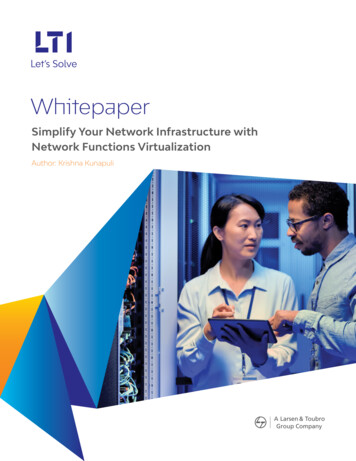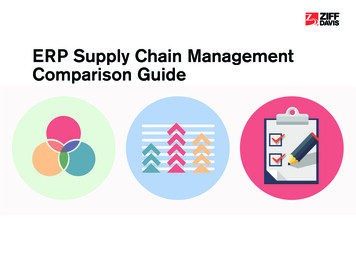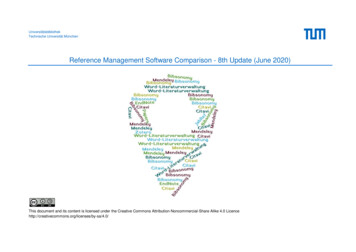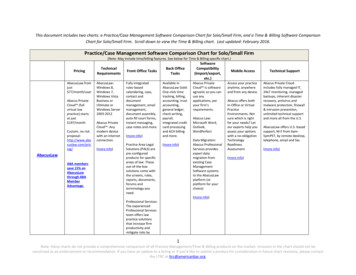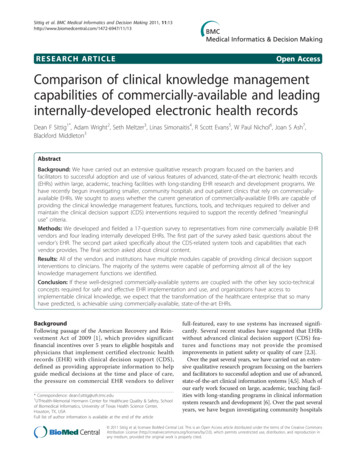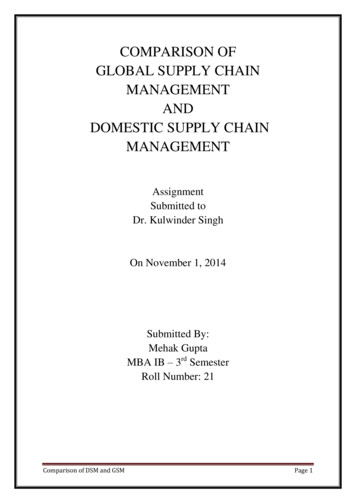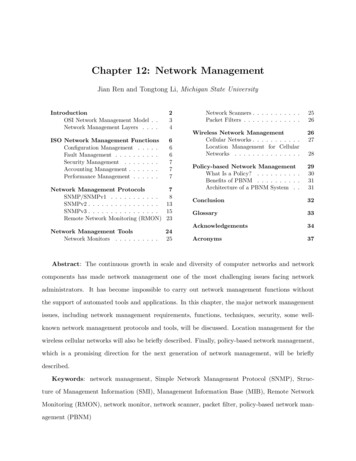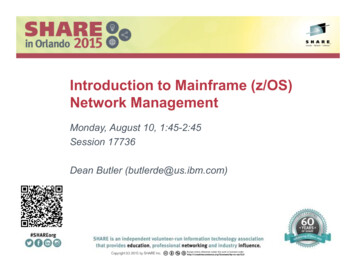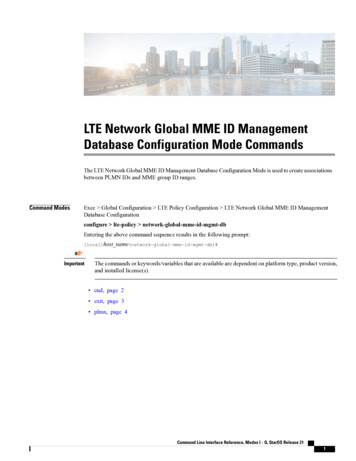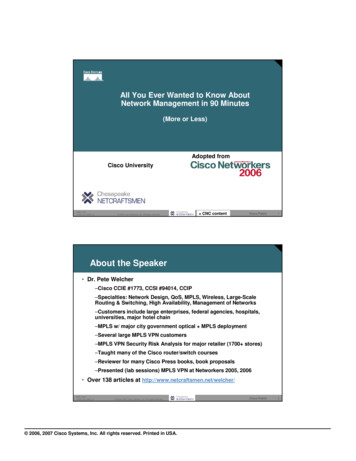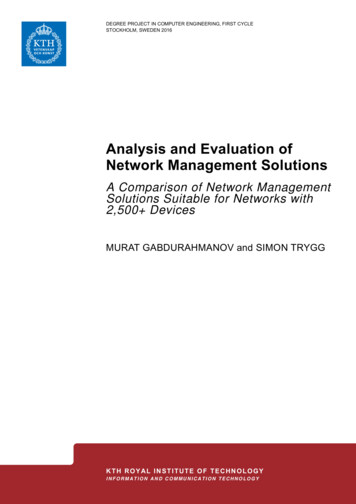
Transcription
DEGREE PROJECT IN COMPUTER ENGINEERING, FIRST CYCLESTOCKHOLM, SWEDEN 2016Analysis and Evaluation ofNetwork Management SolutionsA Comparison of Network ManagementSolutions Suitable for Networks with2,500 DevicesMURAT GABDURAHMANOV and SIMON TRYGGKTH ROYAL INSTITUTE OF TECHNOLOGYINFORMATION AND COMMUNICATION TECHNOLOGY
Analysis and Evaluation ofNetwork Management SolutionsA Comparison of NetworkManagement Solutions Suitablefor Networks with 2,500 DevicesMurat Gabdurahmanov and Simon Trygg2016-06-16Bachelor of Science ThesisExaminerGerald Q. Maguire Jr.Academic adviserAnders VästbergKTH Royal Institute of TechnologySchool of Information and Communication Technology (ICT)Department of Communication SystemsSE-100 44 Stockholm, Sweden
c Murat Gabdurahmanov and Simon Trygg, 16 June 2016
AbstractSome companies today are using sub-optimal and nearly obsolete managementsystems for their networks. Given the large number of different services that aredemanded by users, there is a need to adapt the network structure to support thecurrent and potential future demands. As a result, there is a need for new NetworkManagement Solutions (NMSs).The aim of this thesis project is to help a company who uses a NMS calledLocal Area Network (LAN) Management Solution (LMS). LMS was designedby Cisco for managing LAN networks. However, the company’s demands aregrowing and they need to expand their network more than expected. Moreover,LMS is designed to only support devices by Cisco, whereas the company wants auniversal solution with wide device support from many manufacturers.This thesis presents an analysis of their current system and suggests potentialsolutions for an upgrade that will meet all of the company’s demands and will havea long operating life. To help find reasonable solutions a thorough evaluation oftheir existing NMS and network monitoring and management needs was made.This evaluation gave good insights into different aspects of their system. Areasonable solution was found by following a three-step approach, beginning with82 possible solutions, filtering out and breaking down with each step, until onlythe most suitable NMS was left.Two NMSs has been proposed as equally suitable replacements: IBM TivoliNetcool/OMNIbus and ManageEngine OpManager. Regardless of which one ischosen, they both have the following advantages over the company’s existingNMS: they are very stable solutions which can handle a large number of manageddevices; they are universal solutions with wide device support, and the companycan add custom support if needed; they are user-friendly with the ability to addcustom interfaces; and they both have a professional first-line technical supportdepartment locally located.Keywords. Analysis, evaluation, Network Management Solution (NMS),monitoring, management, Cisco, LAN Management Solution (LMS), Tivoli,Netcool, OMNIbus, OpManager.i
SammanfattningVissa företag använder idag suboptimala och föråldrade övervakningsssystemför sina nätverk. Med tanke på det stora antalet olika tjänster som efterfrågasav användare finns det ett stort behov av att anpassa nätverksstrukturen för attstödja de nuvarande och potentiellt framtida kraven. Som ett resultat finns det ettbehov av nya övervakningssystem (Network Management Solutions (NMSs)) förnätverken.Syftet med detta examensarbete är att hjälpa ett företag som använder NMS:enLocal Area Network (LAN) Management Solution (LMS). LMS utecklades avCisco för att hantera lokala nätverk (LANs). Men med tiden har företagetskrav förändrats och de har därför behövt expandera sitt nätverk mer än väntat.Dessutom är LMS endast utformad för att hantera enheter tillverkade av Cisco,medan företaget vill ha en universal lösning med stöd för enheter från mångaolika tillverkare.Denna rapport presenterar en analys av deras nuvarande system, samt föreslårmöjliga lösningar som kan ersätta detta. Den nya lösningen ska vara långvarigsamt ska uppfylla alla krav företaget ställt. För att hitta lämpliga lösningar haren grundlig utvärdering av den befintliga NMS:en samt en analys av de ställdakraven utförts. Denna analys gav goda insikter i olika aspekter av deras nuvarandesystem. En lämplig lösning hittades genom att följa en trestegsmetod. Metodenutgick från 82 möjliga lösningar, som efter flera steg av filtrering resulterade i demest lämpade ersättningssystemen.Två NMS:er har föreslagits som lika lämpliga ersättare: IBM TivoliNetcool/OMNIbus och ManageEngine OpManager. Oavsett vilken som väljs, harde båda följande fördelar jämfört med den nuvarande NMS:en: de är båda väldigtstabila lösningar som klarar av en stor mängd hanterade enheter; de är universellalösningar med stöd för en stor mängd olika enheter, dessutom går det även attlägga till eget stöd för enheter vid behov; de är användarvänliga och har möjlighettill att anpassa egna gränssnitt; samt att de båda har en professionell first-lineteknisk support placerad lokalt i landet.Nyckelord. Analys, utvärdering, övervakningssystem, nätverk, hantering, Cisco,LAN Management Solution (LMS), Tivoli, Netcool, OMNIbus, OpManager.iii
AcknowledgementsWe would like to thank our examiner Gerald Q. “Chip” Maguire Jr. for hisgreat support throughout the writing of this report by providing us with excellentfeedback and constructive criticism.We would also like to thank everyone at “Netcorp” who assisted us throughoutthe work we did. This thesis project would not have been possible without theirhelp and the access to their resources.Stockholm, June 2016Murat Gabdurahmanov and Simon Tryggv
Contents12Introduction1.1 Background . . . . . .1.2 Problem Definition . .1.3 Purpose . . . . . . . .1.4 Goals . . . . . . . . .1.5 Research Methodology1.6 Delimitations . . . . .1.7 Structure of the Thesis.Background2.1 Network Management . . . . . . . . . . . . . . . . . . . . . . .2.1.1 Background . . . . . . . . . . . . . . . . . . . . . . . . .2.1.2 Fault, Configuration, Accounting, Performance, andSecurity (FCAPS) . . . . . . . . . . . . . . . . . . . . .2.1.3 Simple Network Management Protocol . . . . . . . . . .2.1.4 Command Line Interfaces . . . . . . . . . . . . . . . . .2.1.4.1 Telnet . . . . . . . . . . . . . . . . . . . . . .2.1.4.2 Secure Shell . . . . . . . . . . . . . . . . . . .2.1.5 Secure File Transfer Protocol . . . . . . . . . . . . . . .2.1.6 Hypertext Transfer Protocol Secure . . . . . . . . . . . .2.1.7 NetFlow . . . . . . . . . . . . . . . . . . . . . . . . . . .2.2 Cisco Prime LAN Management Solution . . . . . . . . . . . . . .2.2.1 Functions . . . . . . . . . . . . . . . . . . . . . . . . . .2.2.2 Licences and Limitations . . . . . . . . . . . . . . . . . .2.3 Netcorp . . . . . . . . . . . . . . . . . . . . . . . . . . . . . . .2.3.1 Infractructure . . . . . . . . . . . . . . . . . . . . . . . .2.3.1.1 Customer Network . . . . . . . . . . . . . . . .2.3.1.2 Internal Network . . . . . . . . . . . . . . . . .2.3.2 NMS Requirements . . . . . . . . . . . . . . . . . . . . .2.3.2.1 Required features . . . . . . . . . . . . . . . .2.3.2.2 Preferred features . . . . . . . . . . . . . . . .vii112223345556799910101111121315151516161617
viiiC ONTENTS2.42.53Related Work . . . . . . . . . . . . . . . . . . . . . . . .2.4.1 Survey of Network Performance Monitoring Tools2.4.2 Open Source Networking Tools . . . . . . . . . .2.4.3 Large Scale Network Monitoring . . . . . . . . .2.4.4 Comparison of Network Monitoring Systems . . .Summary . . . . . . . . . . . . . . . . . . . . . . . . . .Method3.1 Research Process . . . . . . . . . . . . . . . . . . . .3.1.1 Step 1: Gathering and Filtering . . . . . . . .3.1.2 Step 2: Theoretical In-Depth Analysis . . . . .3.1.3 Step 3: Practical In-Depth Analysis . . . . . .3.2 Research Paradigm . . . . . . . . . . . . . . . . . . .3.3 Data Collection . . . . . . . . . . . . . . . . . . . . .3.3.1 Interviewing . . . . . . . . . . . . . . . . . .3.3.2 Web-Based Research . . . . . . . . . . . . . .3.3.3 Direct Contact . . . . . . . . . . . . . . . . .3.3.4 Testing . . . . . . . . . . . . . . . . . . . . .3.4 Planned Measurements . . . . . . . . . . . . . . . . .3.4.1 Test Environment . . . . . . . . . . . . . . . .3.4.2 Hardware/Software to be Used . . . . . . . . .3.5 Assessing Reliability and Validity of the Data Collected3.5.1 Reliability . . . . . . . . . . . . . . . . . . . .3.5.2 Validity . . . . . . . . . . . . . . . . . . . . .3.6 Planned Data Analysis . . . . . . . . . . . . . . . . .3.6.1 First-Level Filtering . . . . . . . . . . . . . .3.6.2 Second-Level Filtering . . . . . . . . . . . . .3.6.3 Real-World Testing . . . . . . . . . . . . . . 2931324Finding the Best Network Management Solution334.1 Step 1: Gathering and Filtering . . . . . . . . . . . . . . . . . . . 334.2 Step 2: Theoretical In-Depth Analysis . . . . . . . . . . . . . . . 344.3 Step 3: Practical In-Depth Analysis . . . . . . . . . . . . . . . . 345Analysis5.1 Minor Results . . . . . . . . . . . . . . . . . . . . . . . . . . .5.1.1 Results From Theoretical Analysis . . . . . . . . . . . .5.1.1.1 CA Spectrum . . . . . . . . . . . . . . . . .5.1.1.2 CA Unified Infrastructure Management (UIM)5.1.1.3 Cisco Prime Infrastructure . . . . . . . . . . .5.1.1.4 HP Intelligent Management Center (IMC) . .35353536383939
C 10HPE Network Node Manager i (NNMi) . . . .HPE Network Automation . . . . . . . . . . .IBM Tivoli Netcool/OMNIbus . . . . . . . . .ManageEngine OpManager . . . . . . . . . . .op5 Monitor Enterprise . . . . . . . . . . . .Opmantek Network Management InformationSystem (NMIS) . . . . . . . . . . . . . . . . .5.1.1.11 SevOne . . . . . . . . . . . . . . . . . . . . . .5.1.2 Results From Practical Analysis . . . . . . . . . . . . . .5.1.2.1 HPE Intelligent Management Center . . . . . .5.1.2.2 HP Network Node Manager i . . . . . . . . . .5.1.2.3 IBM Tivoli Netcool/OMNIbus . . . . . . . . .5.1.2.4 ManageEngine OpManager . . . . . . . . . . .5.1.2.5 Opmantek Network Management InformationSystem . . . . . . . . . . . . . . . . . . . . . .Major Results: The Final NMSs . . . . . . . . . . . . . . . . . .Reliability and Validity Analysis . . . . . . . . . . . . . . . . . .Discussion . . . . . . . . . . . . . . . . . . . . . . . . . . . . . .5.4.1 Choosing the Right NMS . . . . . . . . . . . . . . . . . .5.4.2 Limitations . . . . . . . . . . . . . . . . . . . . . . . . .5.4.3 Honourable Mentions . . . . . . . . . . . . . . . . . . . .5.4.3.1 GroundWork Monitor . . . . . . . . . . . . . .5.4.3.2 Kratos NeuralStar . . . . . . . . . . . . . . . .5.4.3.3 Other Honourable Mentions . . . . . . . . . . .53545656565758585959Conclusions and Future Work6.1 Conclusion . . . . . . . . . . . . . . . . . . . . . . . . . . . . .6.1.1 Goals . . . . . . . . . . . . . . . . . . . . . . . . . . . .6.1.2 Insights and Suggestions for Further Work . . . . . . . .6.2 Future Work . . . . . . . . . . . . . . . . . . . . . . . . . . . . .6.2.1 What has Been Left Undone? . . . . . . . . . . . . . . .6.2.1.1 Testing Stability . . . . . . . . . . . . . . . . .6.2.1.2 Cost Analysis and Comparison . . . . . . . . .6.2.1.3 Evaluation of Security . . . . . . . . . . . . . .6.2.1.4 Exploring Combinations of Three or More Tools6.2.2 Hints to the Next Person . . . . . . . . . . . . . . . . . .6.3 Reflections . . . . . . . . . . . . . . . . . . . . . . . . . . . . .6.3.1 Method and Planning . . . . . . . . . . . . . . . . . . . .6.3.2 Work Process . . . . . . . . . . . . . . . . . . . . . . . .6.3.3 Result . . . . . . . . . . . . . . . . . . . . . . . . . . . .6.3.4 Economical and Environmental Sustainability . . . . . . 54648495152525353
xC ONTENTS6.3.5Ethical Considerations . . . . . . . . . . . . . . . . . . .Bibliography6667A Long lists73A.1 Wikipedia: List of Network Monitoring Systems . . . . . . . . . 73A.2 Complete List of Network Management Tools . . . . . . . . . . . 75B Detailed Results77B.1 OpManager’s price list . . . . . . . . . . . . . . . . . . . . . . . 77B.2 Detailed data from step one . . . . . . . . . . . . . . . . . . . . . 78C Reviews About International Business Machines (IBM) TivoliNetcool/OMNIbus83
List of Figures2.12.22.3SNMP request/response vs traps . . . . . . . . . . . . . . . . . . 8LMS main view . . . . . . . . . . . . . . . . . . . . . . . . . . . 12Netcorp’s infrastructure . . . . . . . . . . . . . . . . . . . . . . . 153.13.2Research process . . . . . . . . . . . . . . . . . . . . . . . . . . 23Filtering process flow chart . . . . . . . . . . . . . . . . . . . . . 30B.1B.2B.3B.4Detailed data from step one (1/4)Detailed data from step one (2/4)Detailed data from step one (3/4)Detailed data from step one (4/4)xi.79808182
List of Tables2.1LMS feature limitations. . . . . . . . . . . . . . . . . . . . . . .14B.1 OpManager’s price list . . . . . . . . . . . . . . . . . . . . . . .77xiii
List of Acronyms and Abbreviations3DESTriple DES. 9a.k.a.AIXAPIASRalso known as. 19, 20Advanced Interactive eXecutive. 45Application Programming Interface. 44, 48, 50Aggregation Services Routers. 27, 28BTOBusiness Technology Optimization. 19CACLICMDBCPECPUCSVComputer Associates International. viii, 18, 21,33, 36–39, 73, 75Command Line Interface. vii, 9, 21Configuration Management Database. 50Customer-provided Equipment. 16Central Processing Unit. 44, 50, 51, 63Comma-Separated Values. 50DESData Encryption Standard. xv, 9EMC2ESXiEUREgan, Marino, Connolly, and Curley. 39, 73, 75Elastic Sky X Integrated. 42Euro. 38, 39f.k.a.FCAPSFMSFreeNATSformerly known as. 18, 38, 73–76Fault, Configuration, Accounting, Performance,and Security. vii, 2, 6, 21, 24, 55, 61Flexible Monitoring System. 74, 76Free Network Automatic Testing System. 73, 75GBGbpsGigabyte. 27Gigabit per second. 8xv
xviL IST OF ACRONYMS AND A BBREVIATIONSGUIGraphical User Interface. 1, 11, 17, 32, 36, 37,39–41, 43, 44, 46–49, 51–55HPHewlett Packard. viii, ix, xvi, 19, 27, 33, 34, 39–45, 52, 73, 75HP Enterprise. ix, 33, 34, 39, 41–43, 52, 53, 57,75Hypertext Markup Language. xvi, 10, 11, 40, 46HTML version 5. 40Hypertext Transfer Protocol. vii, xvi, 9, 10, 21,37Hypertext Transfer Protocol Secure. vii, 10, 11,21, 36HPEHTMLHTML5HTTPHTTPSIBMISPITInternational Business Machines. i, iii, ix, x, 18,33, 34, 43–45, 53, 54, 57, 73, 75, 83Internet Control Message Protocol. 50Information and Communication Technology. 48International Data Encryption Algorithm. 9Internet Engineering Task Force. 10, 26Internet Message Access Protocol. 9Intelligent Management Center. viii, ix, 33, 34,39–41, 43, 52, 53, 57, 75Internet Protocol. 1, 40, 41, 46, 48, 49, 51, 54,58International Organization for Standardization.6, 21Internet Service Provider. 59Information Technology. 47, 48JSONJavaScript Object Notation. 47KPIKey Performance Indicator. 50LANLocal Area Network. i, iii, vii, xvi, 1, 2, 11, 13,21Lightweight Directory Access Protocol. 45, 48,51, 55LAN Management Solution. i, iii, vii, xi, xiii,1–3, 5, 11–18, 21, 25, 28, 37, 39, 61, 75ICMPICTIDEAIETFIMAPIMCIPISOLDAPLMS
L IST OF ACRONYMS AND A MMetro Ethernet. 27, 28Management Information Base. 8, 11, 14, 45, 53,54Multiprotocol Label Switching. 15, 16, 41Network Configuration Manager. 45, 46Network Interface Device. 27Network Management Information System. ix,33, 34, 48, 49, 53, 54, 74, 75Network Management Solution. i, iii, vii–ix, 1–6, 15–21, 24–39, 41–43, 45, 46, 48–59, 61–66,74, 76, 78Network Node Manager i. ix, 33, 34, 41–43, 52,53, 73, 75Network News Transfer Protocol. 9Network Operations Centre. 44, 45Netcool Operations Insight. 43–45, 56Network Performance Monitor. 19, 20, 59, 76OIDObject Identifier. 7, 8OpenKBM Open Knowledge Based Management. 74, 76OpenNMS Open Network Management System. 18, 74, 75OPNETOptimized Network Engineering Tools. 74, 76OSIOpen Systems Interconnection. 16OSI2Objective Systems Integrators. 74, 75PAPDUPOP3PRTGPSIRTPower Admin. 74, 75Protocol Data Unit. 8, 9Post Office Protocol version 3. 9Paessler Router Traffic Grapher. 19, 76Product Security Incident Response Team. 13RADIUSRFCRSARemote Authentication Dial-In User Services.46, 51, 55Really Awesome New Cisco confIg Differ. 18,19, 21, 59, 76Request for Comments. 7, 10, 26, 28Rivest, Shamir, Adleman. 9SCADASECSHSupervisory Control And Data Acquisition. 44Secure Shell. 10RANCIDxvii
xviiiL IST OF ACRONYMS AND A IMUSUXVMVPFMSwedish krona. 41, 45, 46, 77Secure File Transfer Protocol. vii, 10, 16, 21Simple Mail Transfer Protocol. 9Simple Network Management Protocol. vii, xi,xviii, 1, 7–9, 11–13, 19–21, 30, 32, 37, 45, 47,50SNMP version 1. 8, 37, 38, 40SNMP version 2. 8, 9SNMP version 2 community. 9, 37, 38, 40SNMP version 2 party-based. 9SNMP version 2 user-based. 9SNMP version 3. 9, 16, 30, 31, 36–38, 40, 43, 55Secure Shell. vii, xviii, 9, 10, 16, 21, 40, 45, 48SSH version 1. 9, 40SSH version 2. 9, 10, 40Secure Socket Layer. 10Terminal Access Controller Access-Control System. 51Transmission Control Protocol. 1, 10, 47, 58Transport Layer Security. 10User Datagram Protocol. 8User Interface. 10, 40Unified Infrastructure Management. viii, 18, 21,33, 37–39, 73, 75United States. 49, 51, 59Unix. 45VPNVirtual Machine. 27, 39, 42Visualization Performance and Fault Manager.73, 75Virtual Private Network. 10WDMWavelength-division Multiplexing. 16XMLExtensible Markup Language. 40
Chapter 1IntroductionThis chapter describes the background and problems that led to this bachelor’sthesis project, as well as a description of the purpose and goals that are to befulfilled as a result of this project. Lastly, it gives a short summary of the researchmethodology used and delimitations that set the scope of this thesis project.As described further in Section 1.6 on page 3, the company where weperformed this thesis project has requested the name of the company not to benamed in this thesis, hence we will simply refer to the company as “Netcorp”.1.1BackgroundIt is hard for companies to keep track of and support the demands of their rapidlygrowing customer base. This is especially true when it comes to networks. Manycompanies choose to maintain their current network systems (both hardware andsoftware), if they do the job “well enough”, as the employees are familiar withthis system. Furthermore, the introduction of new hardware and software mostlikely requires a learning process. In some cases, it may be worth the timeconsuming learning process if the new system is sufficiently better that it wouldresult in more effective work in the long term. This inertia of existing systems isespecially common for Network Management Solutions (NMSs) as these systemsare complete and it is hard to stop managing the network with the existing systemin order to transition to a new NMS.Cisco Prime Local Area Network (LAN) Management Solution (LMS) is apowerful tool for managing and monitoring smaller networks, meaning it is asuitable tool for LANs. LMS uses the Simple Network Management Protocol(SNMP), a well-known protocol for managing network devices over TransmissionControl Protocol (TCP)/Internet Protocol (IP), to communicate with its manageddevices. Via its Graphical User Interface (GUI), LMS gives administrator(s) the1
2C HAPTER 1. I NTRODUCTIONability to monitor, manage, administer, troubleshoot, keeping track of inventory,etc., of all the
DEGREE PROJECT IN COMPUTER ENGINEERING, FIRST CYCLE STOCKHOLM, SWEDEN 2016 . Analysis and Evaluation of . CA Computer Associates International.viii,18,21, 33,36–39,73,75 CLI Command Line Interface.vii,9,21 CMDB Configuration

